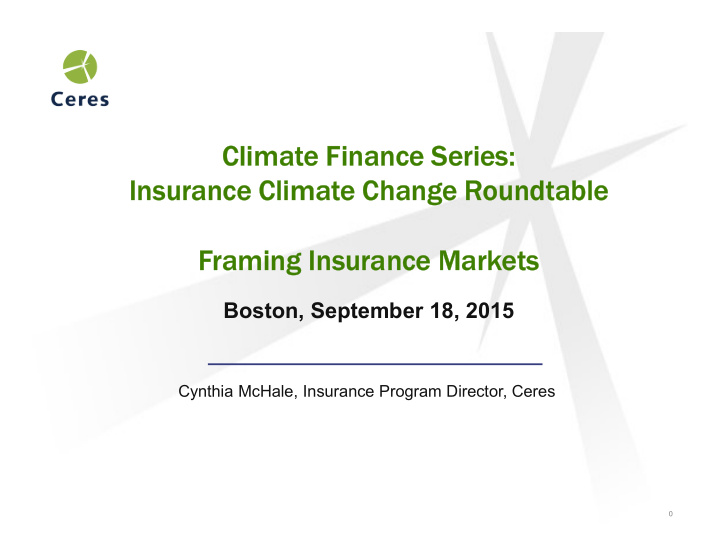



Climate Finance Series: Insurance Climate Change Roundtable Framing Insurance Markets Boston, September 18, 2015 Cynthia McHale, Insurance Program Director, Ceres 0
Those who purchase insurance often have difficulty understanding what risks are covered, and the basis for premium calculation. A typical broad form property policy is a 1-year contract that covers multiple perils, e.g. fire, windstorm, hail, vandalism, explosion and smoke. Insurance for other perils is available by endorsement for an additional premium, e.g. off- premises utility service interruption, flood and earthquake. The premium therefor reflects a “composite” rate which covers several perils and buildings/structures. (Note that fire risk is typically the primary peril driving a business's property rates.) Additionally, catastrophe reinsurance is purchased by insurers to hedge extreme risk and manage capital; the price is based on reinsurers’ amount of capital, varies much more than primary insurance. 1
Furthermore, the property insurance market (much like the real estate market) is intensely competitive, and pricing reflects current market conditions. In soft markets, premiums are stable or falling and insurance is readily available. During hard markets, rates rise, coverage may be more difficult to find and insurers’ profits increase. 2
After a catastrophic loss, premiums spike, most insurers refuse to offer large amounts of coverage and some withdraw from the market. Following a disaster, e.g. Hurricane Sandy in 2012, insurers focus on the large loss and tend to ‘over-react.’ Conversely, insurers tend to underprice their coverage during periods of time when there has not been a serious loss (and interest rates are high.) Insurers, along with their regulators and investors need to avoid fixating on recent large losses and consider the likelihood and size of future claims payments. • Multi-year policies tied to the property rather than the individual/business are one idea being explored. • Such an approach could motivate cost-effective investments that prevent future losses through premium reductions associated with loss mitigation measures. 3
Catastrophic events expose resilience gaps in our built environment that result in major disruptions and large losses. New York City New Jersey • 265,000 properties destroyed/damaged • Severe damage to infrastructure, • 19,729 flights canceled • Major impacts to mass transit & • 2 nuclear power plants down highway systems • Stock Exchange closed 2 days • 2.6 million homes lost electricity • New York Marathon canceled • 346,000 housing units damaged • Estimated cost to NY $33b • Estimated cost to NJ $30b Source: Swiss Re; AonBenfield Impact Forecasting. “Hurricane Sandy Event Recap Report”
These resilience gaps are expected to widen as climate change impacts increase. Growing Extreme Weather Risks (IPCC) Heat waves, average temperatures Droughts and water shortages Heavy precipitation and flash floods Surface water runoff, landslides Sea level rise, chronic inundation More intense hurricane events 5
Future insurance availability and affordability in cities such as NYC and Boston will depend on decisions and investments we make now to increase resilience. NYC: Current Scenario vs. 2050’s $4.4 Expected annual hurricane losses from storm surge and $1.2 + 168% + 70% wind (billion USD) $1.5 + 88% $1.7 6 Source: www.nyc.gov: A Stronger More Resilient New York
Insurers will need to work with regulators, property owners and policymakers to devise new solutions to ensure future insurability. Summary Conclusions The frequency and severity of climate driven natural disasters is increasing. The percentage of natural disaster damage that is insured is decreasing. High potential risks are becoming increasingly uninsurable. The “current state” of resilience response is not adequate or sustainable. A significant investment in resilient infrastructure and development is required. Infrastructure upgrades are critical – adaptation should be implemented as a component of these investments. Source: Adapted from a presentation ‘The Climate Resilience Gap” by Lindene Patton, formerly of Zurich Insurance.
Recommend
More recommend